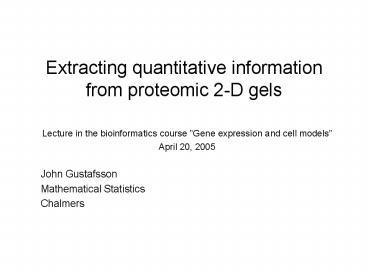Extracting quantitative information from proteomic 2D gels - PowerPoint PPT Presentation
1 / 31
Title:
Extracting quantitative information from proteomic 2D gels
Description:
Lecture in the bioinformatics course 'Gene expression and cell models' April 20, 2005 ... Image analysis of 2-D gels ... the measurement of one protein ... – PowerPoint PPT presentation
Number of Views:63
Avg rating:3.0/5.0
Title: Extracting quantitative information from proteomic 2D gels
1
Extracting quantitative information from
proteomic 2-D gels
- Lecture in the bioinformatics course Gene
expression and cell models - April 20, 2005
- John Gustafsson
- Mathematical Statistics
- Chalmers
2
Proteomics lecturesstarting points
- Anders starting point this Monday
- Lets say that we want to study life at the
protein level what technologies do we have at
hand? - Todays lecture
- How can we get (large-scale) quantitative
measurements of protein amounts? So that we can
do statistics and bioinformatics
3
Content and structure
- Proteomics
- The 2-D gel technology
- Extracting quantitative information
- Image analysis of 2-D gels
- Comparison with microarrays
- Statistic analysis of quantitative 2-D gel data
4
Proteomics
5
2-D gel electrophoresis Protein separation and
quantification
6
A typical 2-D gel experiment
experimental design
Example
7
The image analysis task
- The task
- In each gel image Find and quantify the protein
spots - In the group of gel images Match protein spots
in different images that correspond to the same
protein - Issues
- automation
- time
8
Pseudo-color superposition 1(3)
0M NaCl
1M NaCl
9
Pseudo-color superposition 2(3)
OM NaCl
1M NaCl
10
Pseudo-color superposition 3(3)
(red 0M NaCl, blue 1M NaCl)
11
The standard solution workflow
- In each gel image
- 1. Background subtraction
- 2. Spot detection
- 3. Spot quantification
- In the group of gel images
- 4. Spot pattern matching
12
1. Background subtraction
Before
After
-
13
2. Spot detection / image segmentation
14
3. Spot quantification
15
4. Spot pattern matching
16
The typical 2-D gel experiment
experimental design
Example
17
Limitations
- Technological
- hydrofobic proteins dont dissolve
- limited pI/size coverage
- limited labeling/staining
- Image analytical
- Limited global matching efficiency of automatic
algorithms - Need for time consuming manual guidance
- The image analysis bottle-neck
18
Limited global matching efficiency
Voss and Haberl (2000)
19
Incomplete spot detection Faint spots
Detected
Not detected
20
Incomplete spot detectionClose spots
21
Content and structure revisited
- Proteomics
- The 2-D gel technology
- Extracting quantitative information
- Image analysis of 2-D gels
- Comparison with microarrays
- Statistic analysis of quantitative 2-D gel data
22
Comparison with microarrays
) recently also two-color
23
Variability
24
Variance versus mean dependence
- A dot in the plot
- the measurement of one protein
- The quadratic dependence indicates a
multiplicative error structure
slope2 ? variance ? mean2
(2x5 gel set normal growth condition)
25
Why transform the data?
- A mathematical data transformation can be used to
- Make errors more normally distributed
- Stabilize variance versus mean dependence
- Then the model on transformed scale is more
simple than on original scale - Simplifies the subsequent analysis
26
Logarithmic data transformation
- Stabilized variance versus mean dependence after
a logarithmic data transformation
(2x5 gel set normal growth condition)
27
Statistical analysis of quantitative 2-D gel data
- Examples
- Test of differential expression
- Cluster analysis
- cluster proteins
- cluster cell/tissue samples
- Classification
- classify tissue samples (i.e. tumor classes)
28
Summary
- Proteomics
- The 2-D gel technology
- Extracting quantitative information
- Image analysis of 2-D gels
- Comparison with microarrays
- Statistic analysis of quantitative 2-D gel data
29
An alternative approach to the matching problem
- The standard solution
- First spot detection
- Then matching of point patterns
- An alternative, recent approach
- Matching at the pixel level
- Computationally heavy
30
Gel matching at the pixel level
Reference image
Original image
Aligned image
Image warping
31
Future alternatives to quantitative 2-D gels?
- Quantitative masspectrometry
- Protein arrays































